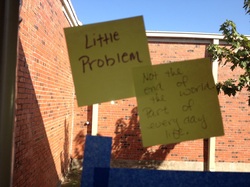
A lot of students have difficulty discerning between little problems and big problems. Most frequently, students that have difficulty with this treat every problem like it is a big one, giving the same reaction to forgotten homework as one might to a broken arm.
The Big Problem vs Little Problem exercise has students place different problems on a continuum of little problem to medium problem to big problem. The picture to the left shows how I did this lesson in my classroom. I put a line of painters tape down my window and put post-it notes with little problem, medium problem, and big problem on the left, middle, and right of the line. We then talk about how you might define little problem (Not the end of the world. Part of everyday life.), medium problem (Not everyday. These are tough but not more than we can handle.), and big problem (These super-stink and take special effort to fix.). Students then place examples of different problems they might encounter on the line where they think they belong.
Some examples of problems are, "forgot lunch," "got a paper cut," "got hurt on the playground," "was involved in bullying," "was expelled." I let students add their own examples but I try to stay away from specific "big problems" that students might have experienced in their own lives. The biggest problems, I make a little bit silly, i.e.: "the school is invaded by aliens." This is especially the case with students who might have experience trauma in their own lives.
This is a fun activity to get kids up and moving, while opening the door to a discussion about different levels of problems and appropriate ways to react when faced with little and medium problems. In addition, the language students learn during this activity can be carried over to the classroom and home to discuss appropriate reactions while in the process of specific situations.
The Big Problem vs Little Problem exercise has students place different problems on a continuum of little problem to medium problem to big problem. The picture to the left shows how I did this lesson in my classroom. I put a line of painters tape down my window and put post-it notes with little problem, medium problem, and big problem on the left, middle, and right of the line. We then talk about how you might define little problem (Not the end of the world. Part of everyday life.), medium problem (Not everyday. These are tough but not more than we can handle.), and big problem (These super-stink and take special effort to fix.). Students then place examples of different problems they might encounter on the line where they think they belong.
Some examples of problems are, "forgot lunch," "got a paper cut," "got hurt on the playground," "was involved in bullying," "was expelled." I let students add their own examples but I try to stay away from specific "big problems" that students might have experienced in their own lives. The biggest problems, I make a little bit silly, i.e.: "the school is invaded by aliens." This is especially the case with students who might have experience trauma in their own lives.
This is a fun activity to get kids up and moving, while opening the door to a discussion about different levels of problems and appropriate ways to react when faced with little and medium problems. In addition, the language students learn during this activity can be carried over to the classroom and home to discuss appropriate reactions while in the process of specific situations.
 RSS Feed
RSS Feed